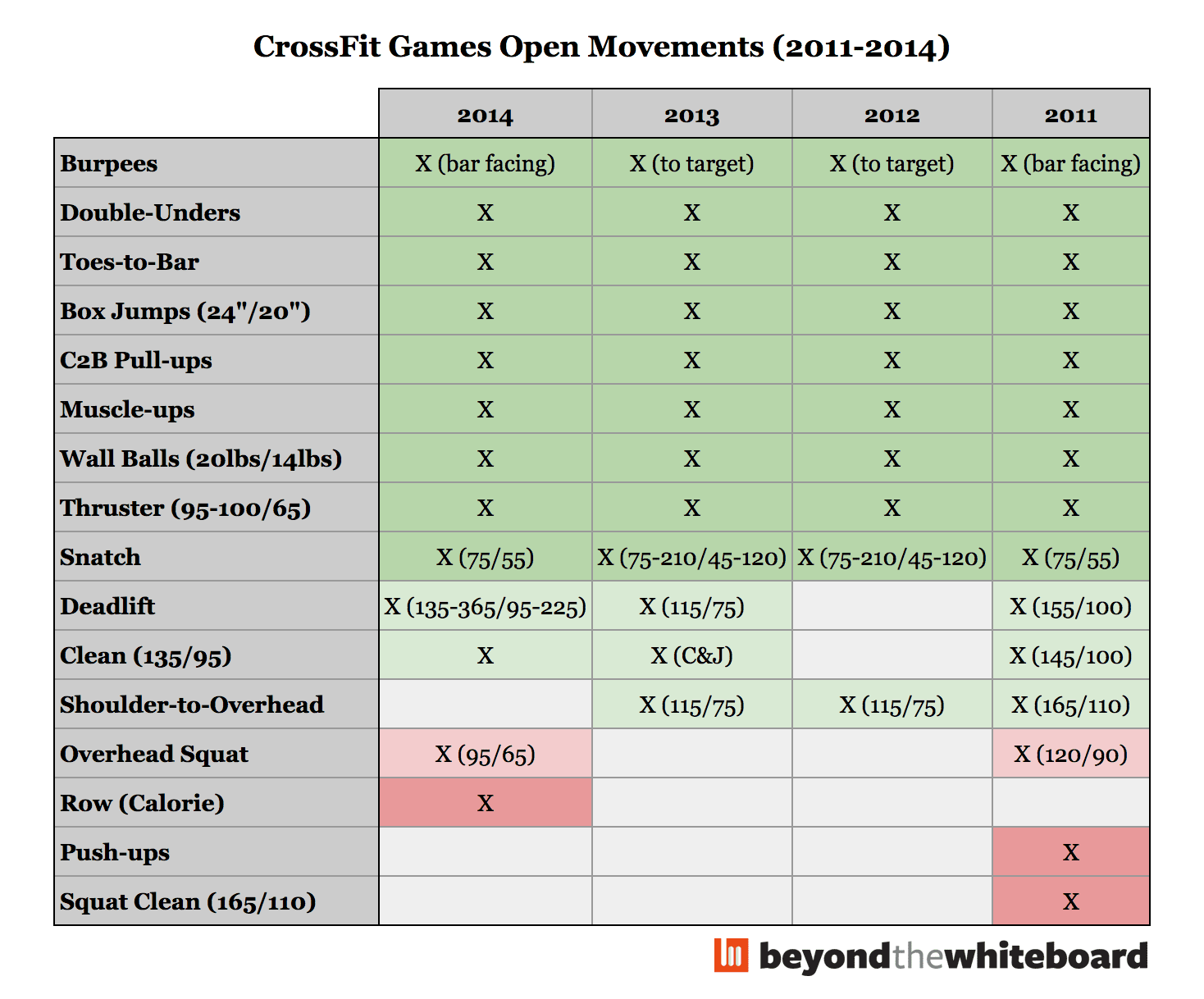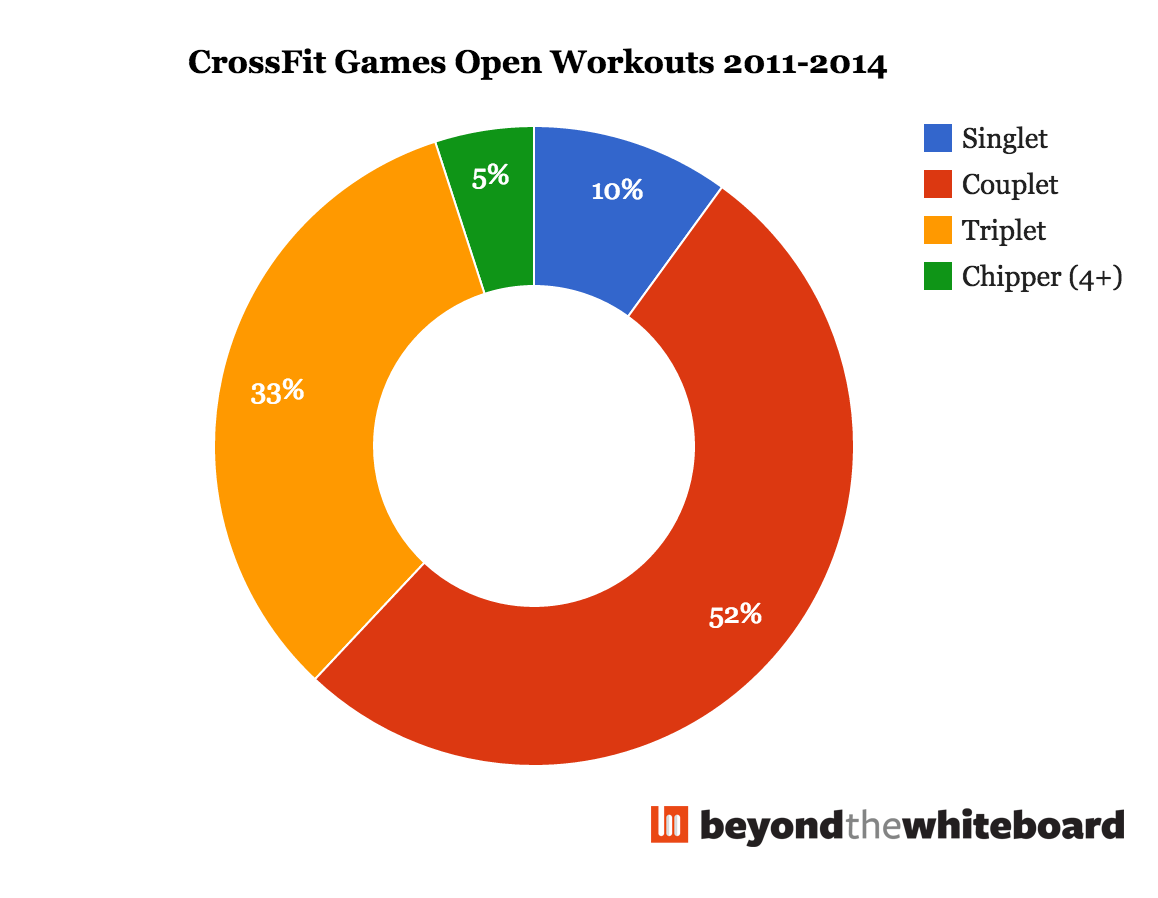CrossFit Games Open 2015: What To Expect
The 2015 CrossFit Games Open is right around the corner, and there are some excitingchanges coming this year. Let’s take a look at how those changes affect our predictions for this year’s Open. The Open format has been surprisingly consistent over the years; analyzing the past four years will also help us gain some insight on what to expect this year.
Movement History
Nine movements have appeared in all four Opens: Burpees, doubles unders, toes-to-bar, box jumps, chest-to-bar pull-ups, muscle-ups, wall balls, thrusters and snatches.
There have been about 16 different movements featured in Open workouts to date (depending on how you count them).
Nine movements have appeared in all four Opens: Burpees, doubles unders, toes-to-bar, box jumps, chest-to-bar pull-ups, muscle-ups, wall balls, thrusters, and snatches. If you are a betting man, put your money here on these showing up again.
Deadlifts, cleans, and shoulder-to-overhead (including push press and jerk) have all appeared in 3/4 of the Opens. Overhead squats have shown up in 2/4. Push-ups, squat cleans, and row for calories have each been included only once.
The row was the only new movement seen last year. In 2012 and 2013 there were no new movements (unless you include switching from push press to shoulder-to-overhead). In light of these facts, it’s not likely we’ll see an influx of new movements this year, perhaps just one or two newcomers.
It’s not likely we’ll see an influx of new movements this year, perhaps just one or two newcomers.
Here are possible movements seen at the Games and/or Regionals that haven’t been featured in the Open (yet): Kettlebell swings, runs (possibly as a shuttle run), dumbbell snatches, abmat sit-ups, air squats, front squats, ring dips, and weighted lunges.
Good candidates for new, advanced movements are handstand push-ups, GHD sit-ups, rope climbs, pistols, and triple unders.
Movement Considerations
It has always been challenging to decide appropriate movements to include in the Open. There are quite a few considerations that must be taken into account. First, it’s important to choose movements that are straightforward to judge. It’s very difficult to develop simple and consistently-enforceable standards for certain movements. For example, in 2011 we saw that “snaking” in push-ups was big problem. We haven’t seen them since. Dips are problematic because they can be cheated by simply leaning over while keeping the hips high. Although we’ve seen some form of the squat each year, what constitutes “below parallel” can vary a lot among judges. This is a big reason for the inclusion of chest-to-bar pull-ups rather than regular pull-ups. They’re just easier to judge.
In addition, the equipment required to compete in the Open is a factor. In the early years of the Open, CrossFit Games Director Dave Castro was careful to avoid a lot of specialized equipment so as to ensure the competition remained as inclusive as possible. But, with the inclusion of Concept 2 rowers last year, all bets seem to be off. Movements like GHD sit-ups and rope climbs appear more possible than ever to make an appearance.
We also can’t forget about video verification. Video verification of workouts “done anywhere” has always been an essential feature of the Open. Beginning last year, CrossFit also added a video requirement for Regional hopefuls. In order to be video friendly, movements must lend themselves to easy verification. Movements like running are difficult to verify on video, due to measurement issues. This is why shuttle runs are a more attractive possibility. Video requirements have also limited the feasibility of longer workouts in the past, although technology has now progressed to where uploading a 40+ minute video is now possible.
Now that there is a scaled option, Dave Castro has more leeway in including advanced movements and heavier weights.
Lastly, the introduction of a “scaled” division broadens the movement spectrum. In past years, because there was only a single division, it was difficult to include advanced movements while still maintaining that the Open was for “everyone”. One ingenious solution to this balancing act was to include muscle-ups at the end of a workout. This made it likely that the athletes who couldn’t do muscle-ups wouldn’t get there anyway. Another workaround was to increase loads the further an athlete made it through a workout (e.g. for deadlifts and snatches). Now that there is a scaled option, Dave Castro has more leeway in including advanced movements and heavier weights.
Workout Characteristics
In previous years, a majority of the Open workouts have been classic couplets or triplets. For logistical convenience, they have been mostly AMRAPs, in the 5-20 minute range. There haven’t been any singlets since 2012, where we saw burpees and snatches by themselves. In 2014, we saw four couplets and one chipper (4+ movements). It was the first time we’ve seen a chipper-style workout (14.4) in the Open. In addition, we saw a pure “for time” workout for the first time ever (14.5). It had an average finish time of just under 20 minutes (99% finished under 30 minutes).
We may see more “for time” workouts this year, and I also expect to see another chipper. In fact, I wouldn’t be surprised if they push the time domain out a little farther for a workout.
Repeat Workouts
Expect to see to a workout from a previous Open in 2015. We’ve seen a repeat workout in every Open since 2011. Each year the repeat has fallen during a different week in the Open. In 2012 it was the last workout. In 2013 it was the 3rd workout. In 2014 it was the first workout. Based on that pattern, it’s hard to predict where we will see it this year. Could we see our first 3-peat this year? If so, which workout is the best candidate for the 3-peat? Maybe 12.4/13.3?
You might be wondering why CrossFit repeats Open workouts each year. It’s not because they lack imagination (as they have been accused of on social media). It’s to provide a concrete data point for comparison over time. The same exact workout performed years apart gives us a true apples-to-apples comparison of human performance. There are now tens of thousands of athletes with multiyear test/re-test data points, which is an incredible benefit to themselves, as well as the fitness community as a whole. There is a lot to be learned by looking at this data over time (and you know we love data).
Here are the repeat workouts from previous Open years:
11.1/14.1
Complete as many rounds as possible in 10 mins of:
30 Double Unders
15 Power Snatches, 75/55 lbs
12.4/13.3
As many reps in 12 mins as you can of:
150 Wall Balls
90 Double Unders
30 Muscle-ups
11.6/12.5
As many reps in 7 mins as you can of:
3 Thrusters, 100/65 lbs
3 Chest-to-bar Pull-ups
6 Thrusters, 100/65 lbs
6 Chest-to-bar Pull-ups
9 Thrusters, 100/65 lbs
9 Chest-to-bar Pull-ups
(keep increasing 3 reps per round)
The “Scaled” Division
An exciting addition to this year’s Open is the scaled division. On any given week, any athlete who is unable to perform the Rx’d workout can decide to do the scaled version instead. They will still be ranked globally and still be eligible for completing Rx’d workouts in the later weeks. However, for that week, they will be ranked below everyone who did it Rx’d, as well as anyone who beat them on the scaled version. This should make it a lot more fun for athletes who, in the past, were stuck with just a handful of reps on certain workouts.
I believe there will still be a clear progression of difficulty between the Open, Regionals and Games. But, with fewer spots available at Regionals, and a field that’s growing ever more competitive, it is crucial that the Open selects the correct athletes.
Even more exciting is what this means for the Rx’d division. There is no longer a need to make the workouts completely accessible. This opens up the possibility of heavier weights and more advanced movements. I don’t personally expect to see a huge increase in difficulty over years past, but I do expect to see things like HSPU and Muscle-ups play a more prominent role in the programming. I believe there will still be a clear progression of difficulty between the Open, Regionals and Games. But, with fewer spots available at Regionals, and a field that’s growing ever more competitive, it is crucial that the Open selects the correct athletes. This means ensuring that the athletes who make it through to Regionals are the ones best suited to competing at the next level. Workouts like 7 minutes of Burpees are not likely to show up again (yay!). Expect couplets, triplets and maybe a chipper. After this year’s Open, there shouldn’t be any doubt as to whether or not athletes advancing to Regionals deserve to be there.
Concluding Thoughts
At the end of the day, no one ever really knows what Dave Castro will do. In a recent video he said that we can expect to see “classic CrossFit” workouts. Quite frankly, that could mean anything. Regardless, you can be confident that blood, sweat, and tears will be shed, and, more importantly, that PRs will be set. Thousands of athletes will get their first double unders, toes-to-bars, chest-to-bar pull-ups, and muscle-ups. As we enter this year’s CrossFit Games season, Teddy Roosevelt’s timeless words from over a century ago seem more relevant than ever,
“It is not the critic who counts; not the man who points out how the strong man stumbles, or where the doer of deeds could have done them better. The credit belongs to the man who is actually in the arena, whose face is marred by dust and sweat and blood; who strives valiantly; who errs, who comes short again and again, because there is no effort without error and shortcoming; but who does actually strive to do the deeds; who knows great enthusiasms, the great devotions; who spends himself in a worthy cause; who at the best knows in the end the triumph of high achievement, and who at the worst, if he fails, at least fails while daring greatly, so that his place shall never be with those cold and timid souls who neither know victory nor defeat.” -Theodore Roosevelt – 1910
Now sign up, get out there, and show the world what you’re made of! We’ll see you on the Leaderboards.


